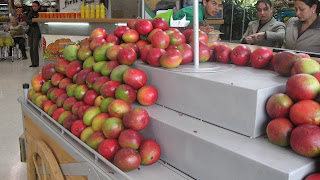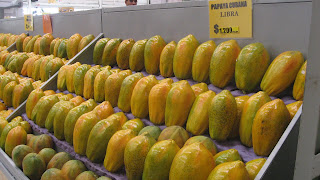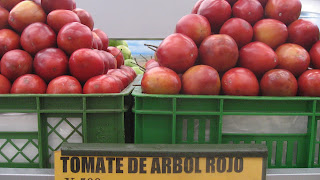
Summer and it's lovely slow heat has finally gotten me, coupled with a few trips (to New York and Bogota), I have been neglecting the spice doc updates! Well, the trip to Colombia was fantastic as it always is, though this time it was a brief 5 days and I didn't get out to the countryside as I usually do. There will be more travelling medicine updates on Colombia in the years to come since it's somewhere I go periodically to visit family.
I managed to get to one lovely veg & fruit market which was filled to the brim with the stunning variety of produce grown in Colombia. Ohhhh the fruits!! I also happened to meet someone who many years ago came across a book called "Las Recetas Medicinales de la Abuelita" which translates to "Grandmothers Medicinal Recipes". Brilliant and basically my dream book in any and all countries from any and all grandma's! I will share some of that kitchen wisdom as well.
Below are some of the lovely pictures from the market as well as from a few meals I cooked while I was there along with other medicinal & tasty food tidbits. Enjoy!

One of the mango varieties they have there (my grandmother refers to it as a "mangito" but I am on the hunt for the official name - it is a small juicy heavenly mango which you can eat the skin of. Mangoes are particularly good for your digestion and are considered nourishing for your system as a whole. Many fruits tend to be too 'damp and cold' in TCM and mango is an exception, along with papaya. Boiling the leaves of mangoes and drinking the tea can be used to treat cough and congestion.

The lovely little mango when I was half way through it.

An almohabana, nothing medicinal about it, unless you want to nourish your soul for breakfast or at tea time (referred to as onces in Colombia). It is a cheese-filled small chewy light doughy baked good.

The entrance to the grand veg & fruit market.

Mangoes.

Granadillas - good for 'moving your stomach' (aka. constipation) if you are having difficulty in that arena.

Mandarinas.

Papaya, which much like mango, is excellent for your digestion and contains a compound called papain which is a digestive enzyme.

Mango yulima.

Mango de azucar.

Papayuela - a mini papaya which is used to make a dessert - they candy it and it is delectable.

A creamy fruit, pitaya, is good for 'moving the stomach' much like granadilla.

Higos, also known as cacti fruit in the U.S. and can be found in Latino grocery stores.

Curuba, I have had this in juice, it's tart with a slight sweetness.

Tomate de arbol, another wonderful fruit that is referred to as a tomato but tastes more like a crisp tart plum with mango flesh?!

Yuca. It is an excellent substitute for the generic potato and is very nourishing and easy on the digestion. I posted recipes for it on the spice doc facebook page. I learned that the wax you find covering the yuca in stores is placed on there to prevent them from rotting or being eaten by bugs since it is so starchy and delicious.

Another potato (papa pastusa) of which there are many in Colombia. If you ever run into tummy trouble, one of these lovely earthy tubers is a good remedy to feed you back to a balanced digestion.

My favorite of the Colombian tubers: papa criolla - a little yellow potato with a balanced sweetness. It is used to make ajiaco which I will feature on here once winter rolls around again. Potatoes in general are used to reduce all bodily inflammations, and a juice can be made to treat burns topically or to drink for internal ulcers.

This is a beautiful small tuber used in the Boyaca region of Colombia. It looks a little bit like a Jerusalem artichoke.

Colombian corn is one of my favorites, it has a much larger kernel and a slightly starchier crunchier taste to it. The silk can be used to make a mild diuretic decoction if you are suffering from edema or swelling of any kind. There used to be 4,000 varieties of corn in the world, but unfortunately due to companies such as Monsanto (which own the supposed 'intellectual property' rights to the genetically modified corn which most of us eat), many varieties of corn are disappearing. So, when you can, ask for different kinds of corn!

Cilantro - the Colombian variety has a thicker stem and more leafiness. It is used in a majority of the cooking to give flavor to salads, meats, stews, etc. Cilantro is an excellent anti-microbial and also helps to awaken taste buds and fight damp conditions it the body (an example would be phlegm).

Lovely fresh purple garlic, I wrote about the medicinal qualities of garlic here.

Gosh it was nice to see a normal sized chicken, and not only that but a variety in taste and kinds of chicken. Here you see pollo and gallina (pollo is the younger chicken (can be male or female), and gallina is the aged female chicken once it has stopped laying eggs). Gallina has a much more 'campo' (countryside) taste to it, therefore it tastes more like a real chicken and should elicit a feeling of warmth and health, it is mostly used for stewing as it is tougher even though it is tastier. In TCM chicken is particularly good for those who have a weak constitution and need additional nourishment, a gallina would be excellent in this case.

Eggs. Lovely tasty orange yoked eggs. Yes, orange not yellow like you see in the U.S. - this is the sign of a really fresh delicious egg. The color is bright and you can really taste the egginess. Much like the taste of chicken, this taste is just that, eggy. It may not be descriptive enough but you must taste a fresh egg to know what I am saying here. Eggs are excellent for people who are experiencing conditions which create dryness in their bodies for they nourish the bodily fluids. They are also used to treat women in pregnancy or post pregnancy, to nourish the fetus and then after to nourish the mother.

The different cuts of meat in Colombia. The meat is all grass fed and is unbelievably delicious.

There are many varieties of avocados in Colombia. Some are a lighter green color and taste, and others a darker silkier green flesh. They are very good for your skin and also for those that need fats but can not digest other oils.

After all that shopping, I went home to make lunch for my family.

A lovely avocado salad with fresh cilantro, olives, onion, and tomatoes.

Some stir fried corn with garlic and cumin.

Papa criolla boiled then lightly crisped with olive oil and salt.

Lunch.

And last but not least (though there is loads more but that will have to remain for later): panela. Panela is unrefined cane sugar which has been heated in copper pots and takes on a brownish hue. It is used all the time to treat digestive disorders and colds. In fact, while we were there we all came down with a slight flu and made agua de panela tea. You boil a piece of it in water, mix with lemon juice, and drink it to stop a cold from furthering. It is the Colombian flu medicine in the kitchen.
4 comments:
Hello there. This is my first time to visit your blog and I enjoyed the fruits that you've shown from Columbia. This is the first post I've read from your blog so I'll keep on reading then. Divina
Hello, Just found your blog. Did you ever find out the official name or variety for that mango de azucar you wrote about? I tasted them in Colombia and want to know more about them as well. Thanks!
MELISSA
"One of the mango varieties they have there (my grandmother refers to it as a "mangito" but I am on the hunt for the official name - it is a small juicy heavenly mango which you can eat the skin of..."
Hi Melissa - Yes, the name of the mango is "mango de azucar" (sugar mango). It's absolutely delicious! Did you enjoy your time in Colombia? Hope you enjoy the blog. Nicole
When cooking, sweet marjoram leaves can be added to soups, stews, tomato sauce, stuffing, legumes and vegetables. Oral Jelly
Post a Comment